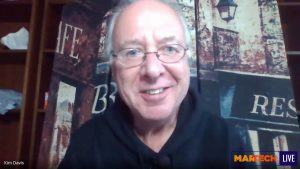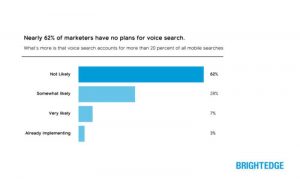 Creating content is the single, most powerful tool in the marketer’s toolbox. Invest in content one time, and if done well, you will reap the rewards of that content for years to come. But I’ve noticed a lot of companies wrestling with what kind of content to create. Most of them make a big mistake in the type of content they craft.
Creating content is the single, most powerful tool in the marketer’s toolbox. Invest in content one time, and if done well, you will reap the rewards of that content for years to come. But I’ve noticed a lot of companies wrestling with what kind of content to create. Most of them make a big mistake in the type of content they craft.
After having this conversation multiple times, I thought I would write an article on it. The choice in question is: thought leadership vs. educational content. Now, there is some overlap on this – thought leadership content can be educational. However, as a general rule there is a pretty wide gap between the two.
THOUGHT LEADERSHIP VS. EDUCATIONAL CONTENT
Depending on where your company is in its content marketing journey will depend on which type of content will be more effective for you. Let’s dive into the pros and cons of thought-leadership and educational content, and see which businesses can benefit from which kind of content.
When we take on a new client, the first obstacle we have to overcome most of the time is that of little organic website traffic. In some cases, this is close to zero organic traffic.
Organic traffic is free traffic – that which comes from search engines results pages (SERPS) and is the backbone of a sustainable inbound marketing strategy. Our focus in the beginning stages of inbound is to build this free, organic traffic so that our lead nurturing campaign and our sales funnel will be full of new prospects.
When organic traffic is flowing at a steady pace, you don’t have to pay for traffic, and you can invest the money you would otherwise spend on PPC into other, more profitable areas.
But it all starts with organic traffic. And this is where we find educational content flourishing.
EDUCATIONAL CONTENT
Answering the questions of your potential customers is the best way to build sustainable, organic traffic. We’ve written extensively about how consumer behavior has changed, and all buying decisions start on Google. Those Google searches are usually in the form of questions.
These questions can be on price, quality, problems, how-tos, and many other types of questions. If your content addresses these questions, you will start getting traffic from search results. This is the kind of traffic you want, as these are very targeted viewers.
As you write more and more educational content, and you answer more questions, the growth of organic traffic can skyrocket. We’ve written about the results of company’s organic traffic here: Does Inbound Marketing Really Work?
In that story, I shared a graph where organic traffic had risen to about 4,000-5,000 a month. But this is how the graph for that same company looks now, about six months later:

As you can see, organic traffic has not leveled off yet. It’s still growing significantly month over month. This isn’t counting the traffic they are getting direct, or from social media shares, or from e-mail marketing, and every other channel. This naturally results from people searching for answers on Google – in other words, 10,000 brand new potential customers every month.
In short, this company now has no shortage of leads every month, and their content is consumed and shared by thousands of fans. This is the power of creating educational content, providing helpful, honest advice, and giving your potential customers what they want.
THOUGHT LEADERSHIP CONTENT
This is where a lot of companies with low traffic make a critical error. They believe thought leadership creates long-term growth. They’ve read a lot of blogs about creating content that is “valuable” and they spend too much time trying to push the envelope of thought.
This is great, don’t get me wrong. Thought leadership content is the best way to set yourself apart from the competition, and stake your claim as an industry leader. It’s the only way to keep traffic.
But if you have no one to read those deep thoughts, do they do any good?
Here’s an example:
- Education Topic: “How Much Does an Apple Computer Cost?”
- Thought Leadership Topic: “Why an Apple Computer Is a Better Long-Term Investment Over PC.”
If you don’t know how to tell them apart, use this simple rule: Search Engine Usage. No one is going to ask Google: “Is an Apple computer a better long-term investment than a PC?” But thousands ask, every single month, “How Much Does an Apple Computer Cost?”
THE ROLES OF EACH TYPE OF CONTENT
Using the example above, let’s examine the role of each type of content. The educational content attracts them because it addresses the very questions they are asking.
If you write an education topic, “How Much Does an Apple Computer Cost?” and it ranks (in this example) #1 in SERPS, you will get thousands of visits every month to people reading that article. They are voluntarily coming to your site to see if you can answer their question and give them clarity.
What will keep them on your site? Probably, offering them an article on why paying a higher premium price up front could actually save them money long-term. That article: thought leadership.
Each plays a role; each doesn’t do the other’s job very well.
WHAT KIND OF CONTENT DO YOU NEED TO FOCUS ON?
That depends on where your traffic levels and lead generation is right now. If your organic traffic is low, focus on educational content until you feel you are filling your lead funnels up sufficiently. That could be 5,000 organic visits a month, or it could be 10,000. It differs for each company. But set a goal to reach and you will get there by offering educational content.
If you’re having trouble coming up with educational content topics, read this blog post: How to Come Up With 100 Blog Post Topics in 60 Minutes or Less.
Once you have a sustained influx of organic traffic, consider integrating thought leadership articles into the mix. These will be articles your organic visitors are more likely to share on social media, and comment on. But it’s the educational content that will be the backbone of your organic traffic growth.
And without organic traffic, you have nothing.
(203)








